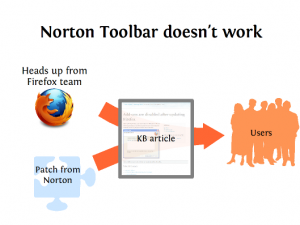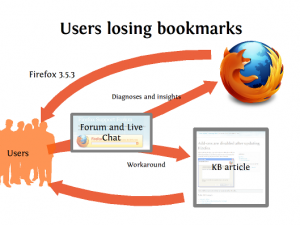Over the past quarter, there has been an effort with Firefox Support around working closer with everyone in the Mozilla community and acting as a bridge between the Mozilla community and the more mainstream segment of Firefox users. We blogged earlier about some of the ways that we can provide feedback to Firefox developers, QA and other members of the Mozilla community. This blog post will focus on some concrete examples of how this close relationship worked in the wake of Firefox 3.5.
Norton toolbar disabled in Firefox 3.5
Symantec did not have the Norton toolbar updated in advance of the Firefox 3.5 push so many users who updated found themselves without a key part of their browser. This understandably upset many Firefox users who interpreted the “Norton toolbar is disabled” message as that they were no longer safe online.
In this instance, a close collaboration with the QA, Add-ons and Firefox team alerted us that this may be a big deal so we got a knowledge base article written right away in advance of the push. Furthermore, with a downloadable patch from Norton, we were able to give these Firefox users a workaround and help make sure that their Firefox 3.5 upgrade went as smoothly as possible.
Lost bookmarks when upgrading
When the upgrade to 3.5 offer was popped up to all 3.0 users, we suddenly noticed a significant increase in the number of users reporting that some or all of their bookmarks were missing. In addition to helping users restore their bookmarks and updating KB articles, we worked closely with the Firefox team to figure out the cause. After collecting files from willing users and doing some detective work in conjunction with affected users, we managed to figure out that these users were actually getting reverted to bookmarks from Firefox 2. This led to a quick patch that rolled out in the next update of Firefox.
What’s really great is how quickly we went from discovering a problem through our forums and live chat into putting out a patch that potentially helped millions of Firefox users who’ve updated since. This loop of getting information from users and turning that into fixes for users is what makes collaboration with the greater Mozilla community so rewarding and why it’s so important.
Problems caused by extensions, plugins and third party software
Being able to work with users experiencing a problem, SUMO also plays a role in identifying extensions, plugins and third party programs that can issues for users. For example, when a number of users complained about not being able to use the right mouse button in Firefox 3.5, we narrowed down that Yahoo Toolbar versions older than 2.0 were the cause. Just this week, SUMO was one of the first places that users reported that AVG was marking Firefox as a trojan. Very quickly, we got a KB article up and within 24 hours, Tomcat in Mozilla’s QA group was able to work with AVG and get updated virus definitions pushed.
Crashes
In addition to the above, we’ve been working on incorporating information about top crashes into the knowledge base and helping connect the developers working on crashes with users experiencing them. As part of that we had a recent sprint to write KB articles for the 30 top crashes and are constantly monitoring new topcrashes. In the upcoming quarter, we hope to really ramp up this effort and make it even faster to get crashed diagnosed or reproduced so they can be fixed.
In general, working closely with support, not only benefits the 4 million SUMO visitors a week, it can also make the Firefox experience better for the 300 million Firefox users out there.
What you can do to help
As a member of the Mozilla community, there are a couple things that you can do to help us work better together.
- Work on, triage or help reproduce common-issue+ bugs. We’re using the common-issue+ keyword to mark issues that we see a lot on support. Getting activity on those bugs helps complete the loop from user via SUMO back to improving the experience for users.
- Mark commonly-duped bugs with the common-issue? keyword. We may not spot every issue or in some cases, the symptoms of a bug are generic and we may not realize they’re distinct from another bug. Marking a bug with the common-issue? keyword lets us know to pay specific attention to an issue and see if it’s actually happening to users who show up on SUMO.
- Help with user support. Working with users relies on having community members answer questions on our support forums and live chat service. It’s really easy to get started and the more user questions we answer, the more information we can feed back to the larger Mozilla community.
The full slides for a brownbag Cheng hosted on this topic can be found here. If you have more ideas for how SUMO can work better with you or other feedback, please let us know in the comments below, in the #sumo IRC channel or via email.


Paul C wrote on
wrote on